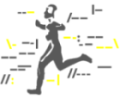





Search | Sitemap | Navigation |  |
|
||||||||||||||||||||||||||
|
||||||||||||||||||||||||||
|
||||||||||||||||||||||||||
|
| Neel Kar |
Pablo Ruiz Picasso (1881-1973)
On-line Picasso Project
dali & picasso. freakizh brain + pain: the perfect formula for art?
A Famous Migraine Suspect"I'd love to know if there are any famous or exceptionally accomplished people who are migraineurs; surely there must be some. Anyone here know of them?" (S. Francis, Newsgroups: alt.support.headaches.migraine, Subject: Re: Famous migraineurs, August 1, 1997) "My mom and I have always thought Picasso might have had them." (Leeanna English, Newsgroups: alt.support.headaches.migraine, Subject: Re: Famous migraineurs, August 9, 1997) |
In his 1970 monograph on migraine, the eminent neurologist Oliver Sacks was the first to note the phenomenal similarity between the stages of the visual migraine aura of mosaic vision and the style of pointillist and cubist paintings, respectively.
Could it be migraine?"Oh yeah, an' you get kewel effects like a criss-cross 'mesh' pattern of (eg) blue luminous lines, and bizarre perception effects not unlike wot Picasso depicted in his later stuff, like profile-view of faces with both eyes, both ears, etc. Somewhat weird. The luminous blue meshes are possibly among the oddest." (Carl LHS Williams, Newsgroups: uk.rec.sheds, Subject: What do you know about migraine?, October 7, 2000) |
Based on medical information supplied by Sacks and by Michel D. Ferrari, Associate Professor of Neurology at the Leiden University Medical Centre, the Dutch designer Arthur O. Eger raised the question, in his monograph on decorative art published in 1995, whether the Spanish painter Pablo Picasso might have suffered from migraine and have used visual migraine aura experiences as a source of artistic inspiration. However, Eger was careful to note that the supposed inspiring visual phenomena are etiologically unspecific and thus could equally have been produced by other pathological conditions such as epilepsy, diabetic hypoglycemia or hallucinogenic drugs.

Arthur O. Eger, Decorative Art - About Style and Basic Form of Decorations and Ornaments. Cantecleer, De Bilt 1995. © 2004 Cantecleer
In a lecture delivered during the Headache World 2000 congress in London, Ferrari suggested a diagnosis of migraine aura without headache in the case of Picasso. The 'migraine theory' on Picasso's paintings (Ferrari and Haan, 2000) really picked up and subsequently was published in about all major newspapers (e.g. The Guardian Unlimited) and even television channels throughout the world, all the way to Australia.
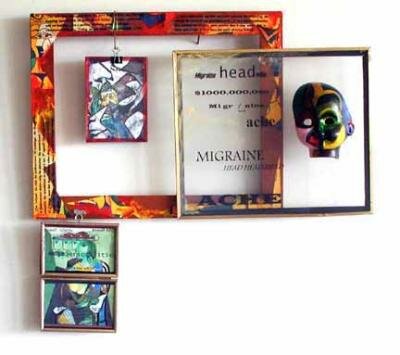
Sona Sandalian, The $ 1,000,000.00 Migraine Headache - Pour Picasso, 2000. © 2004 Sona Sandalian
Sona Sandalian's comment on the notion of Picasso's migraine"This is about a recent article that came from the Neurologist convention about Picasso and that the reason for his fragmented images was because he was suffering from a form of migraine which causes one's vision to be fragmented." [more] |
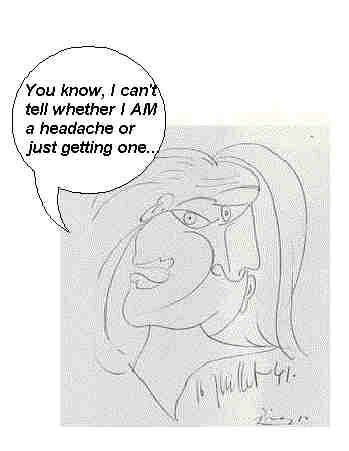
Hobie Lunin, Hobie's Homemade Cartoons − FINE ART − Dep't of Migraine: Picasso strikes again, undated. © 2004 Hobie Lunin (www.user1.netcarrier.com/~hlunin/Picasso.jpg, July 21, 2004)
Trevor Richard Pearce's essay "Deus ex migraine""Oh baby!! Just finished my essay, and I'm feeling pretty darn good! Complete with catchy title: Deus ex Migraine. My professor guffawed when I handed it to her ... it's all about the marketing (I decided not to mention the fact that it had been written in a hour a little over an hour before − it was due fifteen minutes after I arrived). Has anybody read that article in the Sun on Picasso's supposed migraines? That was the topic." (Trevor Richard Pearce, e-diary from December 11, 2000, http://www.littlesputnik.net/trpearce/updates.htm, August 5, 2004) |
However, whereas striking phenomenal similarities between visual migraine aura symptoms and Picasso's paintings undoubtedly exist, these alone cannot prove the 'migraine theory' on Picasso's paintings, since all types of visual illusions and hallucinations encountered in migraine can also be produced by other pathological conditions, as implied by Heinrich Klüver's notion of hallucinatory form constants.
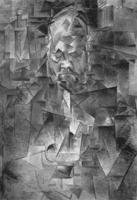
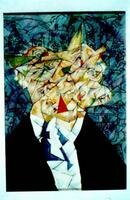
(left) Pablo Picasso, Portrait of Ambroise Vollard, 1910. © Succession Picasso/ VG Bild-Kunst, Bonn 2005 (right) Migraine Art: Mosaic vision. © 2004 Migraine Action Association and Boehringer Ingelheim
A migraine sufferer's report of mosaic visionSir, this might be of some interest for the readers: a full description of a "classic" Migraine-aura (all visual ingredients; typical for the weird appearance of such an "aura"): it all starts with a minute blind spot near the center of view. This spot is growing slowly and one can see some kind of rotating movement around it (like moving embroidery). It is growing... By now you are in a state of panic because you think there is something badly wrong with the eyes (for those who never experienced something like this before: it is frightening!). Still growing... By now, the rotating movement looks like a broad ribbon of crackled metal foil surrounding an area that looks very much like "white noise" on a TV-screen (the growing blind spot). The "embroidery" could also be compared with a wriggling mass of (white, grey and black colored) dancing and running "Tangram"-like figures (geometrical shaped dancing figures). Still growing..., until the whole field of view is a hyper-active mass of "zig-zag" (or lightning-like) V-shaped structures. It's as if the wriggling expanding mass surrounding the blind area is a swarm of locusts leaving a devastated field! Gradually the sight is coming back near the center of view, but it's coming in "twisted bits and pieces" (very much like a painting of Pablo Picasso!). Your ears receive some sort of "twisted sound", and speaking is almost impossible. When all visual phenomena are gone and normal sight is coming back, that uneasy feeling starts, with headache on one side of the head... I only had one attack of Migraine, in june 1996, but this was enough for me to have a very vivid "souvenir" of it! One can't forget something like this! (made a fine drawing of it, the next day after the appearance). (Danny Caes, February 12, 2003) |

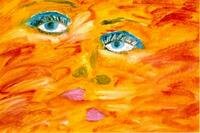
(left) Pablo Picasso, The weeping woman, 1937. © Succession Picasso/ VG Bild-Kunst, Bonn 2005 (right) Migraine art: Illusory vertical splitting. © 2004 Migraine Action Association and Boehringer Ingelheim
A migraine sufferer's report of illusory vertical splitting"The picture [Migraine Art: illusory vertical splitting] is meant to show what I see, but the eyes are how I feel ... The onset of an attack is always marked by zigzag lines that are very fluorescent. During an attack things seem distorted, people's faces seem to be split, they are also blurred. The time it lasts is varied, but mostly about 20 minutes. Once I have burped, the lights and distortion disappear and I then have a headache and feel sick." (Cited from Podoll and Robinson, 2000) |
A migraine sufferer's report of facial metamorphopsia"actually, i just get what i call 'blinkers' - two large black flaps come down on either side of my face and my peripheral vision just disappears completely - and then that narrows into complete tunnel vision and it's fade to black. in between i get what i call the Picasso Effect, where people's eyes suddenly migrate to the same side of their noses when i look at them, or their mouths expand until the corners are nudging their ears, such stuff. but if i once get the blinkers, it's over - it's into a dark room for three days witth the blinds drawn and everyone being very quiet, dammit. i don't seem to HAVE triggers, not obvious ones anyway. i've had migraines at all times and places, and honestly, i can't even say that the12 year old one i was and the forty year old that i am can even HAVE many of the same triggers. [...] i just... get them, they arrive without warning and they HAMMER me." (Alma Hromic Deckert, Newsgroups: rec.arts.sf.composition, September 25, 2003) |
Thus, the phenomenal similarity of an artist's works with certain hallucinatory form constants - e.g. the similarity of Picasso's paintings with mosaic vision, illusory vertical splitting or metamorphopsia, respectively - never permits to infer the presence of inspiring visual experiences of a specific etiology such as migraine, if such diagnosis is not supported by additional evidence from autobiographical writings and/or contemporaries' observations. In the case of Picasso, both Eger (see Goossensen, 1996) and Ferrari and Haan (2000) explicitly stated that they didn't find any supportive information in Picasso's biographies, although they didn't record which works from the large literature they had actually scrutinized, so the possibility remains that maybe further studies of the said literature will yield new pieces of medically relevant information that have hitherto escaped attention.
To prevent an inflated use of the said diagnostic attribution in pathographic studies of famous painters from the history of art, Podoll et al. (2003) recommended, as a methodological standard that should be fulfilled in studies of the migraine aura as artistic inspiration, that a diagnosis of migraine can be supported by semi-/autobiographical writings and/or contemporaries' observations in addition to the evidence derived from the analysis of the artworks.
References
Eger AO. Decoratieve Kunst. Over Stijl en Grondvorm van Decoraties en Ornamenten. Cantecleer, De Bilt 1995.
Ferrari MD, Haan J. Migraine aura, illusory vertical splitting, and Picasso. Cephalalgia 2000; 20: 686.
Goossensen J. Kubisme uit een slordige hersenpan. Hervormd Nederland, 21 December 1996, 52-53.
Klüver H. Mechanisms of hallucinations. In: McNemar Q, Merrill MA (eds) Studies in personality. Contributed in honor of Lewis M. Terman. McGraw-Hill, New York-London 1942, 175-207.
Podoll K, Robinson D, Nicola U. L'ipotesi di un'origine emicranica della pittura di Picasso: una rassegna critica. [The migraine hypothesis on Picasso's paintings: a critical reappraisal. In Italian.] Confinia Cephalalgica 2003; 12: 11-23.
Sacks OW. Migraine: The evolution of a common disorder. University of California Press, Berkeley-Los Angeles 1970.
Author: Klaus Podoll
Last modification of this page: Wednesday March 23. 2005
| Neel Kar |
 Top of the page
Top of the page| · | News |
| · | Medical Professionals |
| · | Medical Studies |
| · | $ 1,000,000.00 Migraine |
| · | Salvador Dali |
Copyright © 2005 Migraine Aura Foundation, All rights reserved. Last modification of this site: August 25, 2006
Thanks to: RAFFELT MEDIENDESIGN and GNU software | webmaster@migraine-aura.org
http://migraine-aura.org/EN/Pablo_Ruiz_Picasso.html
